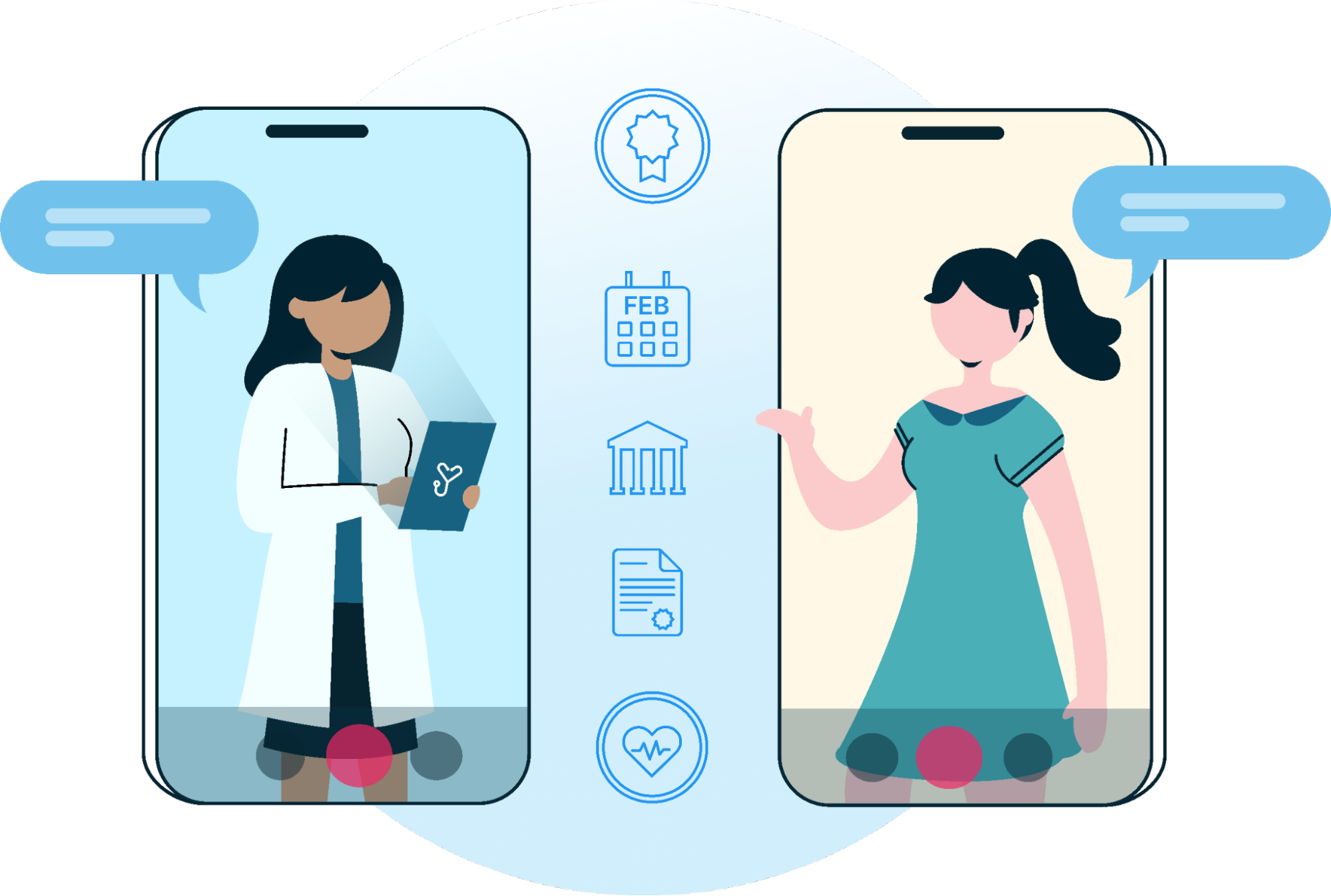How To Improve Telehealth Connectivity Issues in 2022

Make buffering and latency a thing of the past. Learn how to solve telehealth connectivity issues with the latest innovations in technology.

If you’ve ever experienced telehealth connectivity issues, you already know how frustrating it can be for your practice. After all, if you can’t easily connect with your patients, delivering virtual care can be challenging or impossible. In this article, we’ll first explore the common issues that affect telehealth connectivity. Then we’ll discuss the exact solutions you can implement to create a more productive, profitable, and thriving practice.
3 Problems Surrounding Telehealth Connectivity
There are three significant issues that can impact the connectivity of telehealth services.
- Slow internet connection. One telehealth connectivity issue is that telehealth services often rely on high-speed internet connections for delivering care. However, many patients — especially those in rural areas — may not have access to high-speed internet. This can make it difficult for people in those areas to use telehealth services.
- Difficult login process. A website with a lengthy registration process or login can frustrate patients. This may cause them to not show up for their appointment. Given that the number one reason providers implement telehealth in their practice is to increase productivity, this is a big issue.
- No guidance for technical issues. If a patient experiences technical issues before an appointment, this could lead to a decrease in both staff and provider productivity, as well as further patient no-shows.
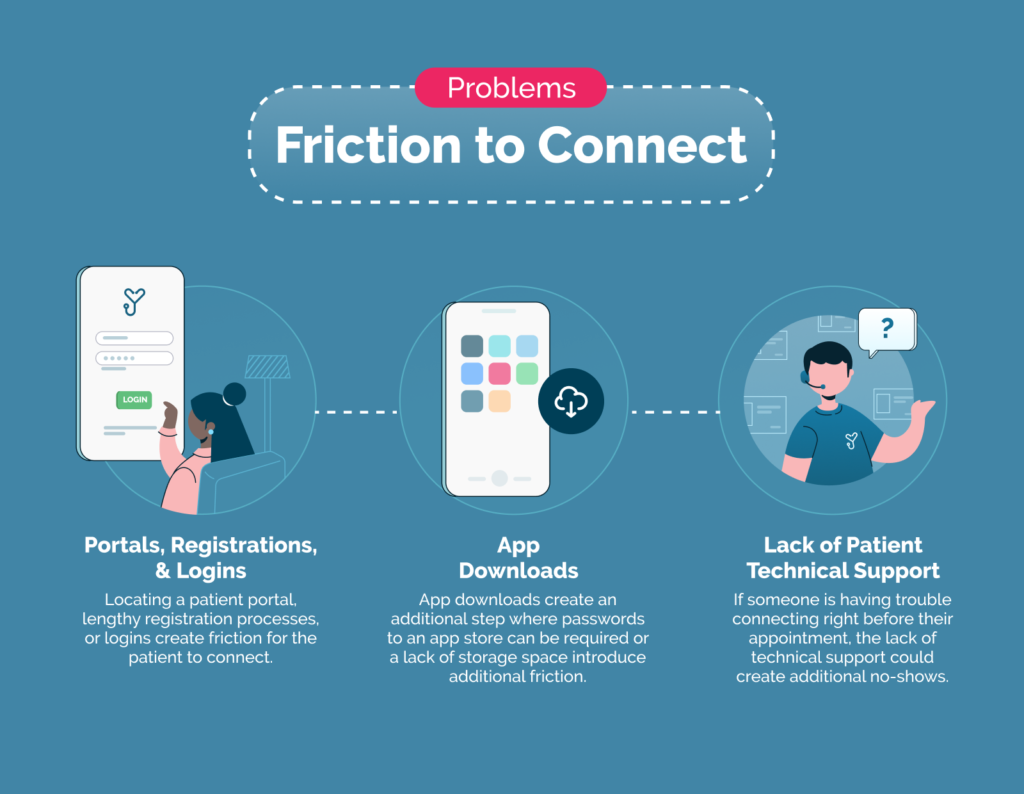
Solutions for Telehealth Connectivity Issues
Telehealth connectivity issues can be frustrating. The good news is that these common issues are easily solvable with the right platform. Let’s explore how innovations in telehealth technology can address these problems.
Internet Connection
Problem: Slow internet connection
Solution: Ability to support low bandwidth connections, audio fallback capabilities, and other backup options
Connectivity is always going to be a high priority with telehealth. When connection fails, it’s often due to low bandwidth. In other words, information can’t be sent effectively (which is why lag time occurs) or the connection can’t be made at all.
The ability to connect even on low bandwidth is vital for the success of virtual visits. This means that you need a telehealth partner that can work on low bandwidth connections. In addition, there need to be audio fallback capabilities if video fails.
With Mend, you have options when it comes to video use. You can use our 100% web-based video for single or group appointments. Using this reduces the bandwidth use by 74% over platforms like Doxy, Doximity, and Google Meets. Mend also integrates with Zoom, WebEx, and Microsoft Teams to facilitate visits if necessary or preferred.
If at any time the bandwidth is too low to connect with a video visit, Mend has the capability to support audio at very low speeds. Backup options like our phone dialer are also in place to ensure the success of every visit.
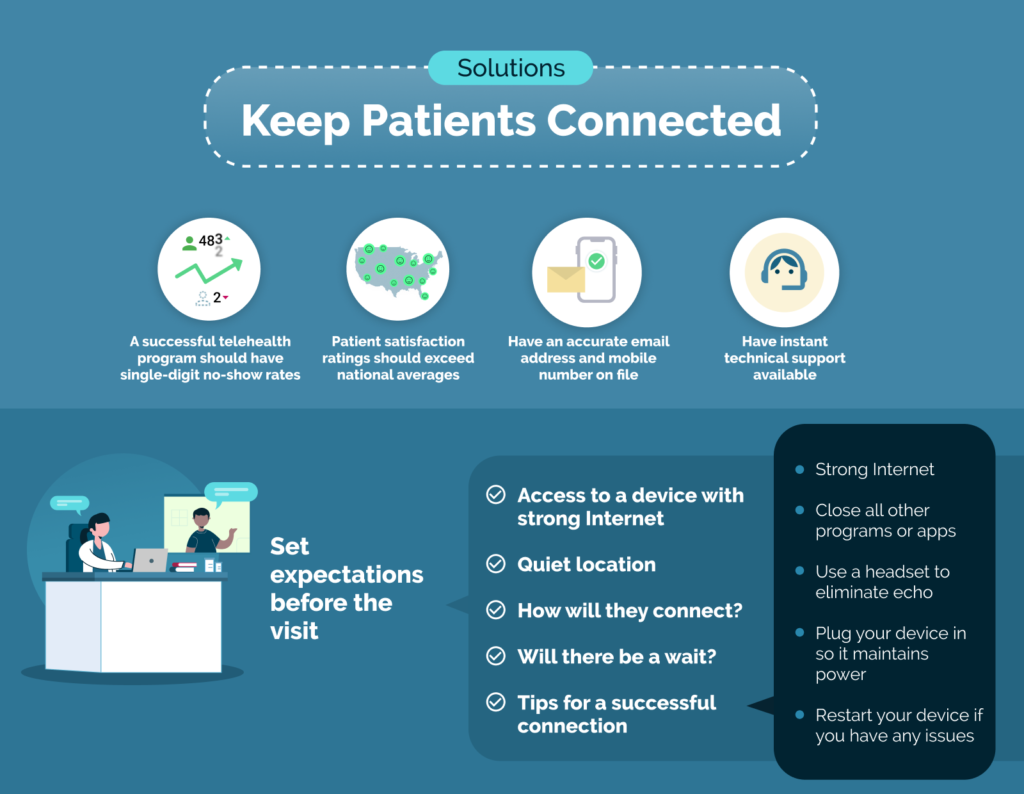
Login Process
Problem: Difficult login process
Solution: Frictionless connection with a secure link
Some telehealth services require the use of specific apps or software. These can be difficult to install and use, especially if patients have limited data or space on their devices. Additionally, some apps may not be compatible with software that people already have. This can make the adoption of telehealth services difficult.
One solution is to use a telehealth service that offers a frictionless process for connecting. Mend has a patented process that makes connecting easier than ever.
It starts with the sending of an automatic text message or email with a secure link. After the patient confirms their date of birth, they can connect from any device. With this process in place, over 94% of visits are successful with Mend. When patients are able to connect easily, this can keep patients happy and engaged in their care.
The benefit of a secure link can also extend beyond the virtual visit alone. Patients can also connect easily to complete digital intake forms and pay for their visits.
While the login process may seem like something small, keep in mind that patient satisfaction is a vital element to consider as healthcare trends evolve. Patients are now expecting digital health processes to be seamless. In fact, sixty percent of consumers expect their digital healthcare experience to mirror that of retail. Another recent study shows that 91% of consumers prefer an electronic payment method for their medical bills. A well-designed telehealth service can provide all of these solutions.
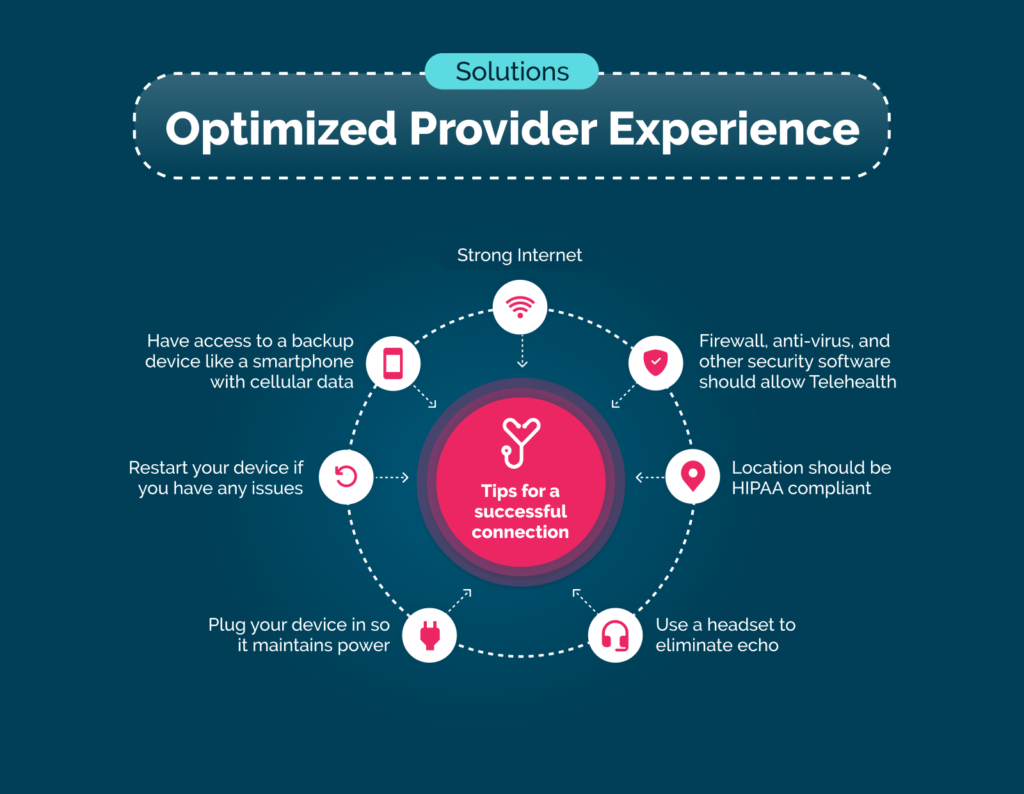
Technical Support
Problem: No guidance for technical issues
Solution: Quick and responsive technical support team
Sometimes a connectivity fix is as simple as refreshing the device or performing a restart. However, if this guidance is unavailable at the time of service, staff productivity rates and patient retention could suffer.
As a result, it’s essential to use a telehealth & patient engagement platform that includes a dedicated support team who offers a quick response time to any issues. At Mend, the average response time is 15 seconds for technical support.
While only 0.5% of visits require technical support, A.I. capabilities can assist with instant automated responses and resolutions to questions about wait time or filling prescriptions, for example. It’s also possible to create instant automated responses and resolutions unique to your practice using A.I. capabilities.
While having technical support staff available 24/7 is essential, you can also take connectivity a step further by identifying problems before they even have a chance to happen.
With some platforms, it’s actually possible to assess which patients may have a poor internet connection prior to their virtual visit. Mend, for example, will help develop processes to connect these patients when connectivity issues are identified ahead of the scheduled appointment. In other instances, telehealth kiosks can be made available for patients to use.
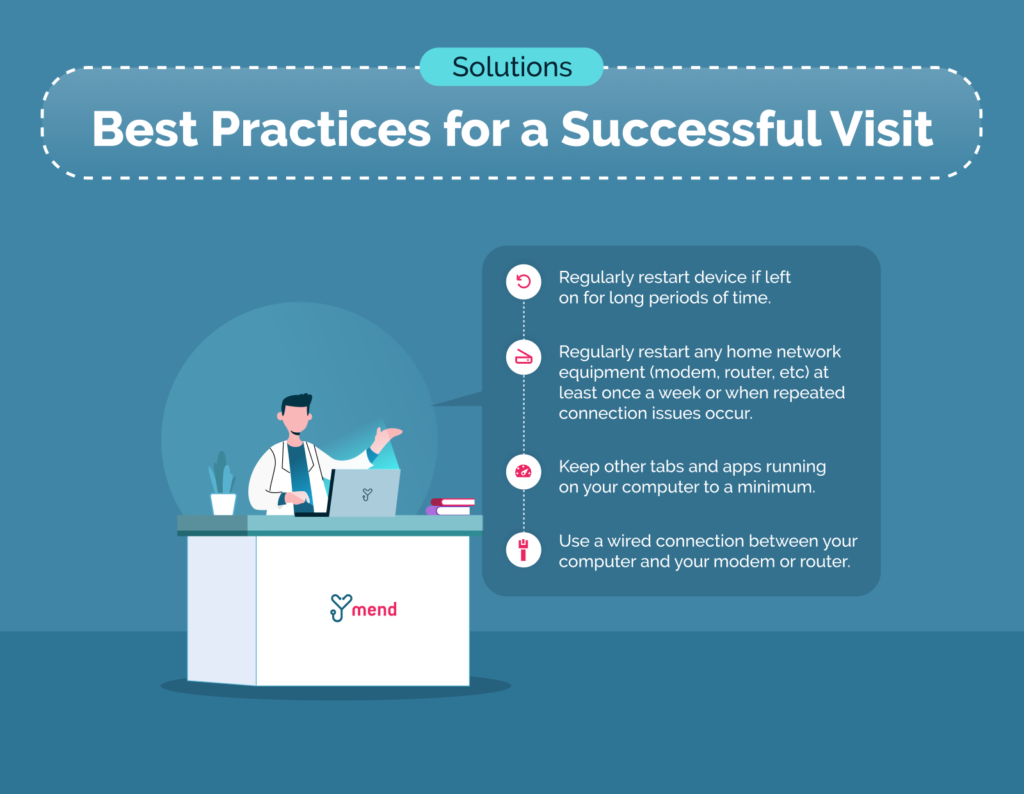
Conclusion
In order to create a successful telehealth program, reliable connectivity is of utmost importance. Solving a connectivity issue starts by defining the problem. Most connectivity issues stem from poor workflows, friction to connect, or slow internet speeds — all of which you can solve with a dedicated telehealth solution. And even if connection issues happen occasionally, a well-designed telehealth program should still maintain single-digit no-show rates and high patient satisfaction scores.
At Mend, we work closely with providers and staff to create seamless digital workflows and solve any connectivity issues — long before they happen. To explore everything Mend has to offer, schedule a demo today with our experts to learn more.
FAQs
What are the barriers to telemedicine?
The most common connectivity barriers to telemedicine are easily fixable. They include slow internet speeds, lack of technical support, and overwhelming software requirements for the patient and provider. A well-designed telehealth program can solve these issues. This can result in decreased no-show rates, increased patient retention, and higher patient satisfaction.
Why is telehealth not working on my computer?
Telehealth connectivity issues most often stem from poor workflows, friction to connect, or problems with internet bandwidth. Closely examining connection quality, as well as other telehealth KPIs, on both the patient and provider sides can help improve overall outcomes. A support team is also helpful to have on hand.
How to fix echo for a telemedicine session?
Headsets or headphones can greatly reduce echo during virtual visits. Providers can run a few tests before seeing patients for the first time to ensure the quality of their video calls. Staff may also share a checklist of helpful tips for patients. These tips may suggest finding a quiet, private location as well as recommending headphones.
Keyword:
Find a Topic:
Recent Posts
- Compassionate Foundations: Self-Care for Mental Health Providers
- Behavioral Health News: Mend Partners with Leading Community Mental Health Organizations to Reduce No-Shows and Increase Access to Care
- Understanding SAMHSA’s Key Changes to 42 CFR Part 8: A Guide for Healthcare Professionals
- Becoming a CCBHC: Staffing Requirements
- Empowering Change: SAMHSA’s Impact on Behavioral Health Through Grant Funding, Innovation, and Collaboration
